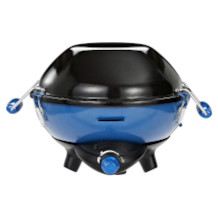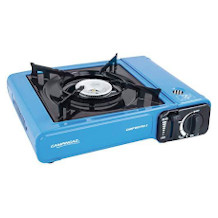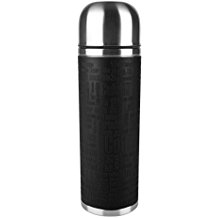Camping chair purchasing advice: how to choose the right product
- What you need to know
- There are different types of camping chairs, from stools to high-back chairs, which differ in terms of weight, seating comfort, and transportability, among other things.
- Whether for long-term campers, hikers, or festival visitors — which camping chair is the right one is primarily decided by the intended use.
- Criteria such as the size, the material, and the load capacity of the camping chair determine the purchase decision just as much as other available features.
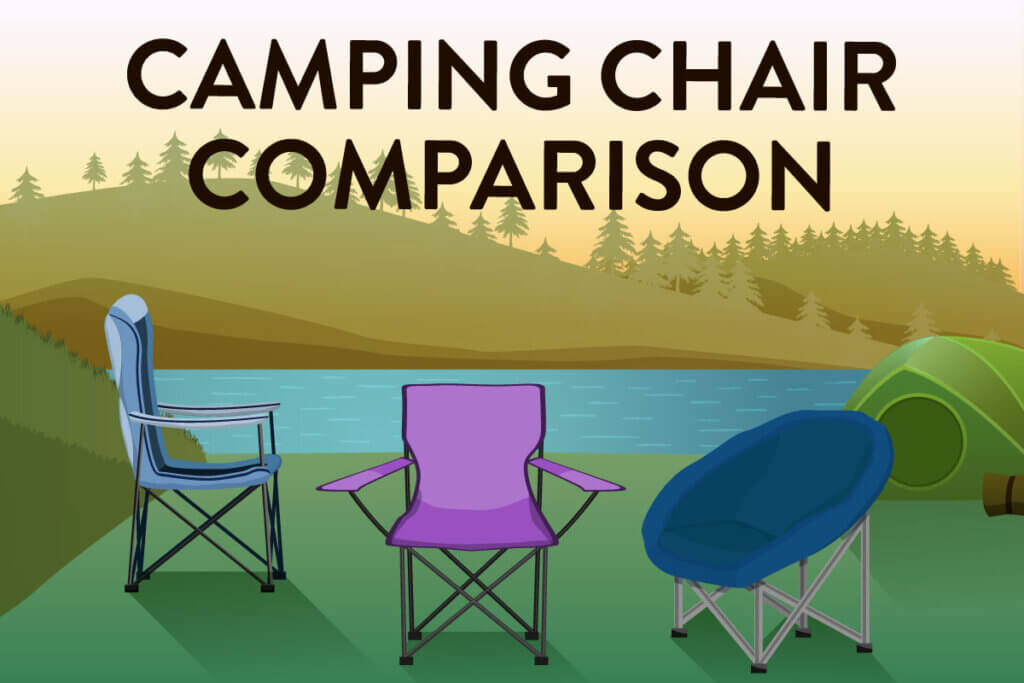
Take a seat
You don’t have to be a classic camper to appreciate a good camping chair. From campsites to festivals, an outdoor chair will always give you a place to sit down. There are, however, notable differences between camping chairs. No one wants to sit on an uncomfortable chair. But for particularly mobile people like hikers, other factors such as weight and compactness are paramount. The choice of the right camping chair therefore depends on its primary purpose.
The perfect camping chair
A camping chair is an outdoor chair on which people usually sit out in the open or under a gazebo. It can be assembled in a few seconds and simple steps. The comfortable seat offers enough space, nothing pinches or pricks, and the backrest is stable — that’s the ideal.
No one wants to sit on a chair that may collapse. Therefore, it is important to know how chairs differ from each other on many different fronts. These include, for example
- transportability,
- comfort,
- the equipment,
- assembly, and
- weight.
When is a camping chair suitable?
A camping chair is nearly indispensable in certain situations. The name says it all: anyone who likes to spend their weekends or holidays at campsites, needs an outdoor chair. This also applies to trailer parks, because the storage space required is usually small and folding chairs are quite compact. Another example are people on a fishing trip that need a place to sit, as fishing requires patience and stillness. In addition, scenarios such as a meeting in the park with friends, hikes, excursions into nature, bathing lakes, and even your own garden all are ideal for taking along a camping chair.
Good host
Whether guests come by invitation or unannounced: once they are there, they like to be seated. However, regular furniture doesn’t always offer sufficient possibilities. Even then, camping chairs — stored in the basement, for example — are very helpful. After all, a good host should always be able to offer enough seating.
From stool to throne: different camping chairs
Camping chairs are available in various price ranges, from simple to extremely comfortable. They include camping stools, foldable models, high-back chairs, and special chairs. Whether you need a backrest, for example, is an individual decision that depends on how long you sit on the camping chair. However, there is a certain logic to the different designs: the more comfortable the seat, the bulkier it usually is. If you prefer a lightweight, you often have to forego a degree of comfort. Many hikers are happy with a lightweight model that they only use for short breaks — then a rudimentary model will suffice. Visitors to a music festival who stand for long periods at concerts, on the other hand, like to relax in the camping chair with backrest at the tent.
Camping stool
The camping stool is also called a tripod stool and belongs to the simple category of camping chairs. It is extremely light, small, and handy. The folding mechanism also optimizes transport. In terms of stability, however, the stool is less convincing. The seating comfort also suffers because such a chair usually has no backrest and lacks other features such as cup holders.
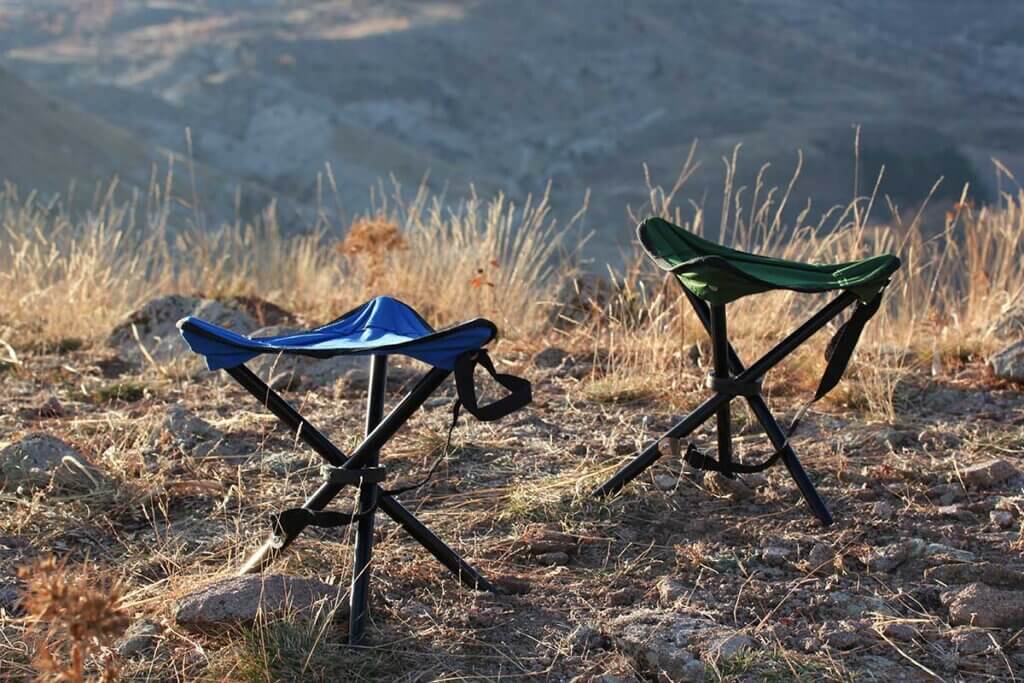
A camping stool is good if the chair is part of the self-carried luggage — for example on hikes or when cycling. Mobile people who carry their seat on their body benefit from the small pack size and low weight.
Advantages
- Particularly low weight
- Very easy to transport
- Extremely space-saving
Disadvantages
- Less stable
- No backrest
- No armrests
- Rudimentary equipment
Folding chair
The folding chair is in the middle class range and is primarily characterized by a high level of seating comfort with back and armrests. Such a model is comparatively light and can usually be folded so that the parts lie on top of each other. This makes it less handy to transport. A folding chair is therefore more suitable if you are travelling by car or van. The metal frame provides stability. Folding versions often do without further accessories.
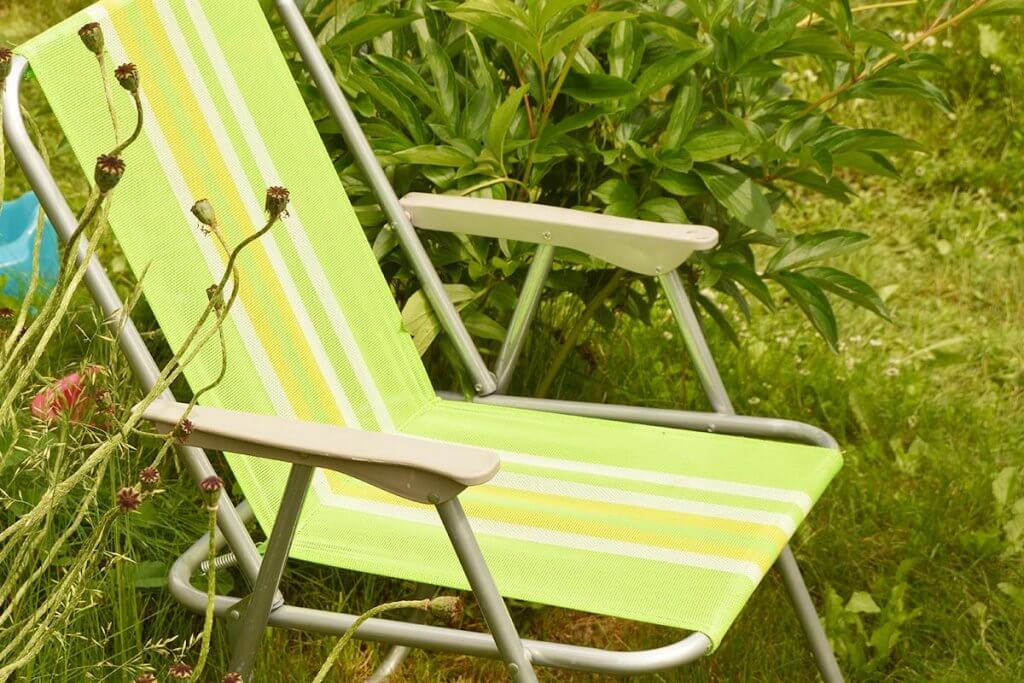
A folding chair is not designed for prolonged carrying. Instead, it is ideal for campers who have their fixed position and don’t need to move with the chair. Thus, a folding chair functions well as a seat at the camping table, for example. It is also ideal for anglers, as they hardly ever change their place.
Advantages
- High seating comfort
- Very stable
- High backrest
- With armrests
Disadvantages
- Kind of bulky
- Not so easy to transport
- Rudimentary equipment
Camp chair
The camp chair is very similar to the folding chair. It is light, offers good seating comfort with arm and backrests and even stands out in terms of transportability. Although the folding mechanism reduces the stability a little, it also reduces the size of the chair so that it can usually be carried easily by hand or otherwise — for example on the side of a camping backpack. Often up to two cup holders are integrated.
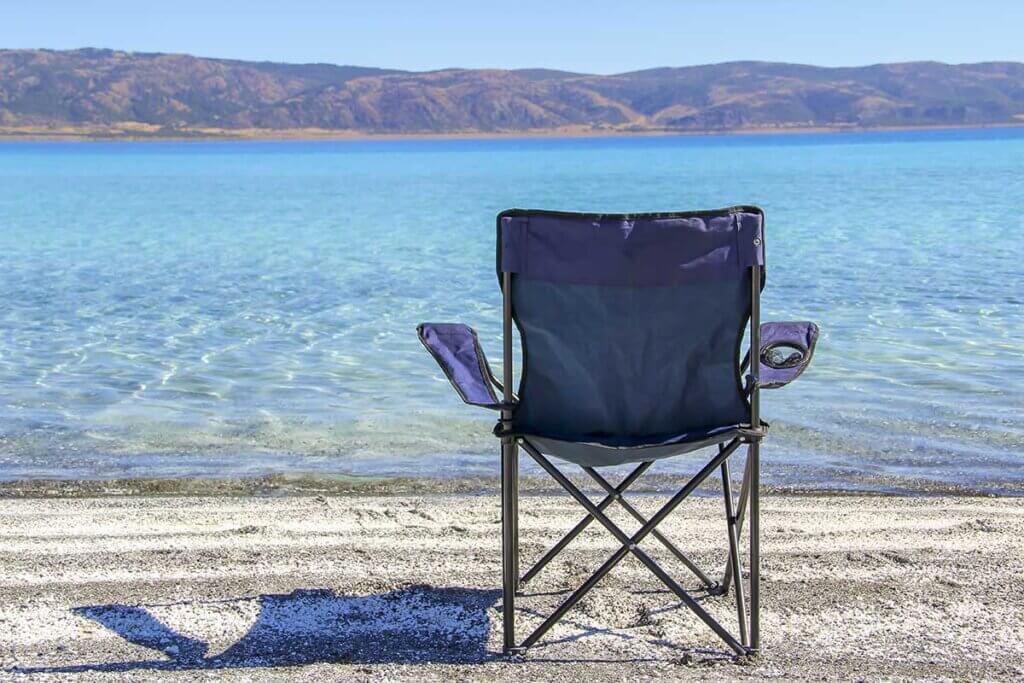
Since it meets all the essential requirements and usually provides a bonus in the form of cup holders, the folding chair is considered the perfect model for festival-goers. The pockets are also ideal for small items such as lighters or disinfectant bottles. Foldable models are also suitable for mobile use, for example when hikers appreciate the advantages of the stool but want back and armrests.
Advantages
- High seating comfort
- Easy to transport
- With backrest
- Wide armrests
- Practical cup holders
Disadvantages
- Comparatively low stability
High-back chair
A high-back chair offers a particularly high level of comfort. With it, you are clearly sitting in the first class of camping chairs. Often, they come with upholstery and a multi-level adjustable backrest that extends above the head. However, the luxurious seating comes at the cost of easy transport, because such a model is very heavy and unwieldy.
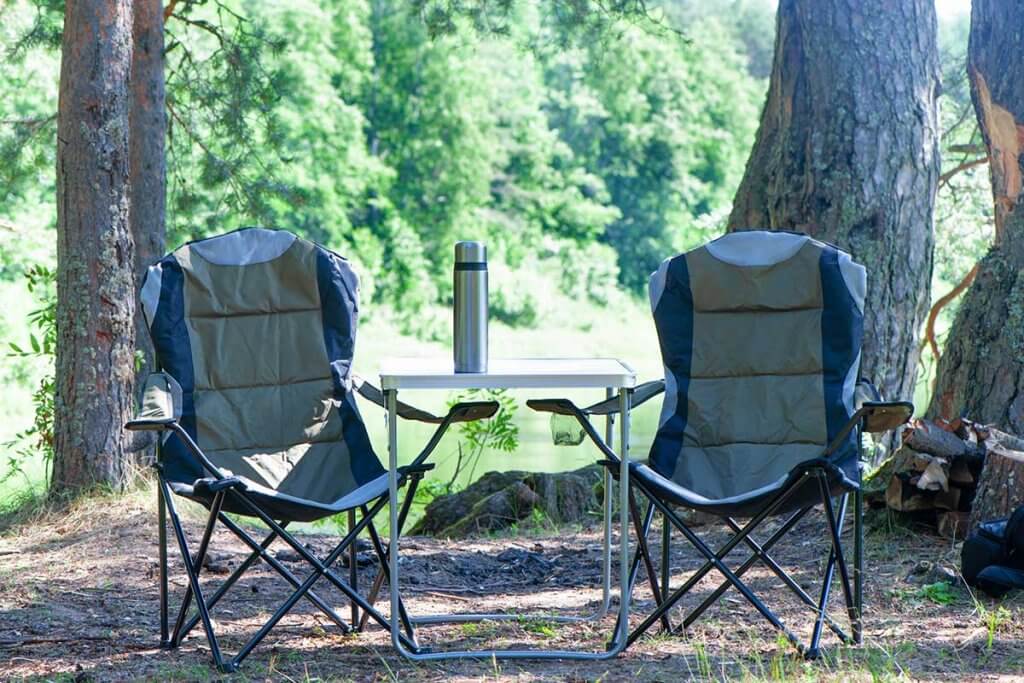
The luxury model is recommended for permanent campers who will only transport the high-backed chair once to the site and store it there. It is also suitable for the home garden or the terrace — whether sunbathing, eating, or sleeping. Many models can even be converted into a lounger.
Advantages
- Particularly high seating comfort
- Extremely stable
- High backrest
- Often padded armrests
Disadvantages
- Particularly bulky
- Very high weight
- Uncomfortable transport
Special chairs
Some camping chairs deserve a separate name such as angler’s chair or hunter’s chair. Such special chairs are designed precisely to meet the needs of certain groups, for example, in the form of built-in rod holders, footrests, or a mechanism that converts the chair into a camp bed. These chairs are usually heavy and unwieldy.
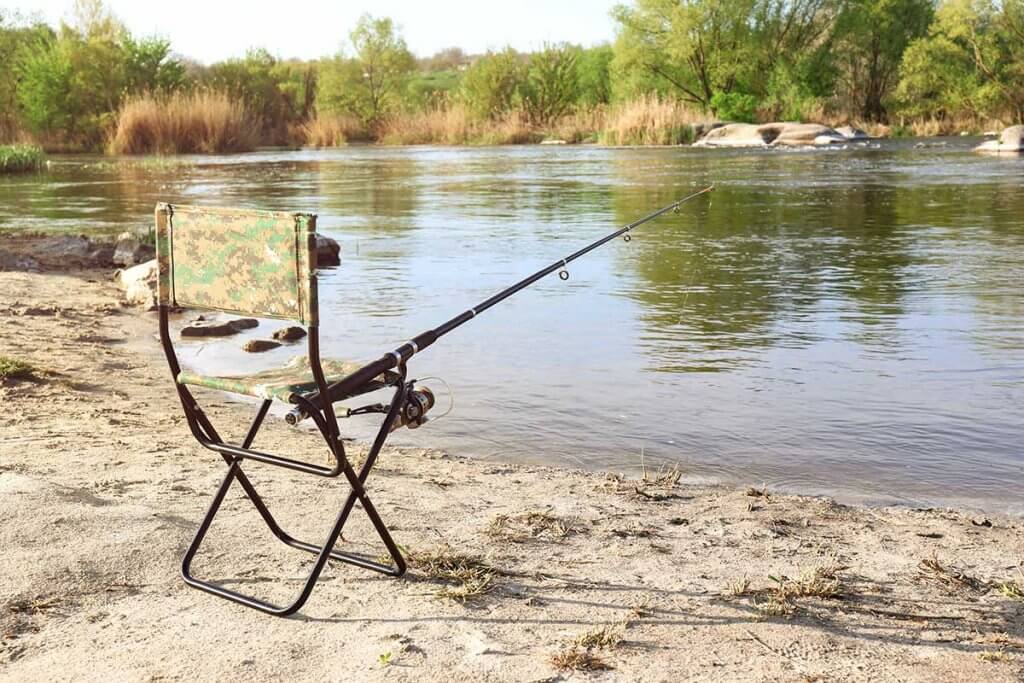
Special chairs come into question if you pursue a specific hobby and want to meet the individual requirements with a suitable chair. Extensively equipped fishing chairs are particularly popular, but beach models with an integrated sunshade also fall into this category.
Advantages
- Optimized functionality
- High seating comfort
- Extremely stable
- Particularly high backrest
- With armrests
Disadvantages
- Particularly bulky
- Very high weight
- Uncomfortable transport
What to look for when buying
The most important purchase criteria are divided into general aspects and features. In addition to size, weight, and material, basic factors include load capacity, stability, difficulty of assembly, and price. In terms of equipment, components such as a headrest, armrests, and cup holders play a role.
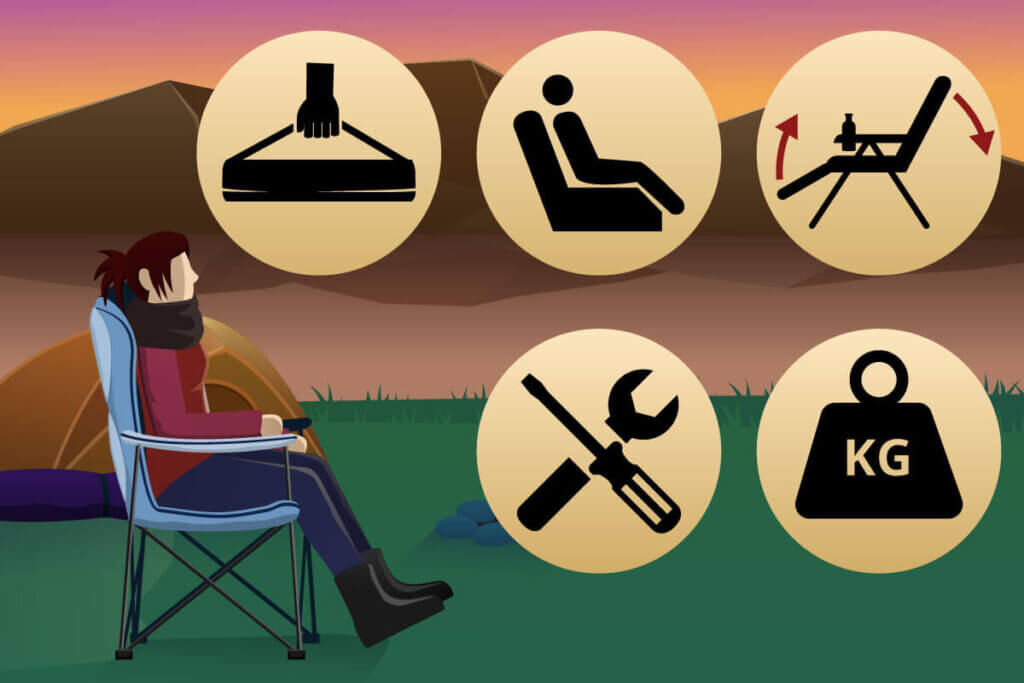
Size
Seat height and seat area determine the size of camping chairs. The range runs from small camping stools to medium-sized folding chairs to large high-back chairs. Stools, for example, have an average seat surface (diameter) of just over 12 inches (30cm) and an approximate seat height of 16 inches (40cm). Some camping stools are height-adjustable. Typical folding stools have somewhat larger seats, up to 20 inches (50cm) wide.
Two criteria are decisive:
- Pack size – size when packed.
- Dimensions – size when assembled.
The smaller the pack size, the easier it is to transport. This is particularly relevant for the foldable festival chair. In fact, it is worth taking a closer look here, as the lengths range from around 32 to 40 inches (80 to 100cm).
Consider your own stature
The body wants to have a say in the matter. Perhaps a stool suits the purpose, but your own stature calls for a larger seat. For very tall people, a higher backrest is recommended.
Material
The best material for camping chairs is sturdy, durable, and lightweight. As a rule, models consist of a metal frame and synthetic fibers. When it comes to metal, aluminum is a good choice because it is very light and more robust than, for example, plastic. Since these are outdoor chairs, the fabric should be as water-repellent as possible or at least quick-drying. Often the seats and backrests are made of hard-wearing polyester — sometimes double-layered.
Wood is impractical
Although wood often offers added visual value, the material is not suitable for camping chairs as it is much more susceptible and thus requires more care. This applies especially to tripod chairs, as some models have a wooden frame and are not foldable.
The material requirements tend to be higher for high-back chairs, as many users like to use such chairs as relaxation loungers — in which case soft upholstery is key. Chairs of this type, however, should be stored in a shed or something similar to protect them from the weather.
Load capacity
The load capacity, specified in pounds/kilograms, is a central criterion when buying camping chairs. If the load-bearing capacity is too low, there is a considerable risk of injury, for example, if metal rods break and protrude from the frame. While the risk for collapsing camping chairs is also related to material quality and workmanship, you should not challenge it with an unfavorable ratio of stated load capacity and body weight.
The specification is particularly important for people with an above-average body weight. The maximum load capacity of most folding chairs averages 265 to 287 lb (120 to 130kg) and ranges up to 330 lb (150kg). The differences are even greater for stools: from just under 220 to over 440 lb (100 to over 200kg). If in doubt, it is a good idea to buy one that promises a higher load capacity. After all, the manufacturer’s specifications are not always accurate. In addition, you then have a certain amount of leeway in terms of your own weight.
Assembly and disassembly
The easier a camping chair can be assembled and disassembled, the more practical it is. Whereby ‘assemble’ hardly applies in this case, because most designs score points with a folding or collapsing mechanism. In rare cases, you do have to separate the cover from the frame and put it back together again during assembly. However, this is not rocket science, we still recommend models in which all components are firmly attached.
Carrying bags are useful
Even a folded camping chair has corners and edges that can be uncomfortable during transport. In addition, there is always the possibility that the chair could open accidentally. Therefore, bags included in the delivery are very practical, in which closed folding chairs can be carried comfortably over the shoulder with the help of a long loop.
Weight
If you are travelling on foot or by bike, you want to keep your luggage as light as possible. Here, too, the correlation is clear: the larger the chair, the heavier it is. On the other hand, the weight at which the carrying comfort decreases depends on individual conditions.
With folding chairs, the range is again wide: from just 4,5 to 13,5 lb (2 to 6kg). This makes a noticeable difference in combination with additional luggage and depending on the duration of transport. Stools are particularly light, weighing only up to a maximum of 2.2 lb (1kg).
Stability
Camping chairs often stand on uneven ground, for example, on a meadow. Then the question arises: does the chair wobble? Is the stand sufficiently secure?
Here, models with additional feet that are slightly movable to compensate for unevenness score points. If the floor is soft, wider chair feet are recommended so that the chair doesn’t sink too deeply into the ground when sitting.
Price
Depending on the design, the price ranges from $10 to more than $100. Camping stools belong to the cheapest category and high-back chairs as well as special chairs to the upper price segment. However, you don’t necessarily have to pay more than $20 for a typical lawn chair either — but then the quality often suffers. Very cheap camping chairs usually only last for one festival season.
Apart from luxury versions and particularly well-equipped special chairs, an outdoor chair for around $50 is a good idea if you are looking for a high-quality, comfortable model that will last for a long time with normal use.
Headrest
Headrests are not a must-have, but they do increase seating comfort. Ask yourself what you use the chair for and how often. Anyone who wants to lean back and relax in a camping chair regularly as well as for long periods of time will clearly benefit from a headrest. This can also apply to festival-goers who often sit in the chair for long periods at night. A plus point: when taking a nap, the head does not tilt back uncomfortably.
Armrests
You sit more comfortably with armrests. Stools don’t have armrests by default, but most other models do. The wider and more padded they are, the more relaxed your arms will be.
Comfortable features
With all the features that correlate directly with seating comfort, the key question is: how long do you sit in the camp chair on average in one go?
Cup holder
Practical cup holders are mainly found on folding and special chairs. If you want to stow other items besides your drink, you will benefit from two drink holders. Ideally, the pockets are so stable that they do not slip when a bottle or cup is placed in them and hold the drink firmly as well as upright.
Does a camping chair need special care?
Careful and hygienic handling of everyday items is important to ensure that they last as long as possible. This also includes regular care — especially for outdoor items. The care required for a camping chair depends on its material. Most frames — aluminum and plastic — can simply be cleaned with water. For stubborn dirt, you can also use a cleaning agent. The same usually applies to polyester. Usually, there is a small label on the chair with cleaning instructions. In particular with upholstery fabric, it is worth taking a look. Make sure to dry everything carefully before folding or collapsing the chair.
Image 1: © FinalCheck | Image 2: © Kybele / stock.adobe.com | Image 3: © clairelucia / stock.adobe.com | Image 4: © zuzu85 / stock.adobe.com | Image 5: © Mariana / stock.adobe.com | Image 6: © Pixel-Shot / stock.adobe.com | Image 7: © FinalCheck

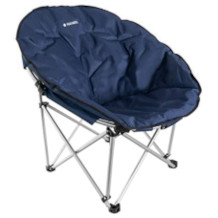
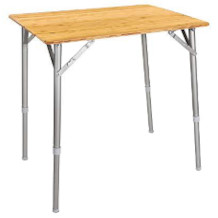







 280 reviews
280 reviews
